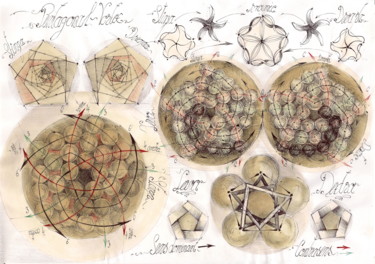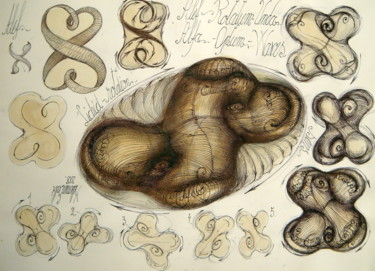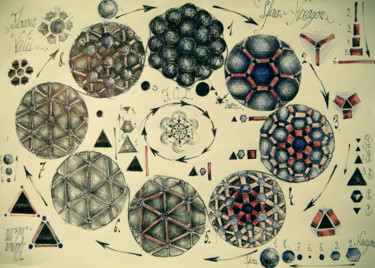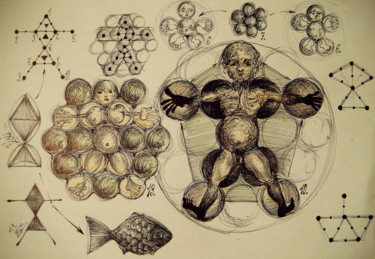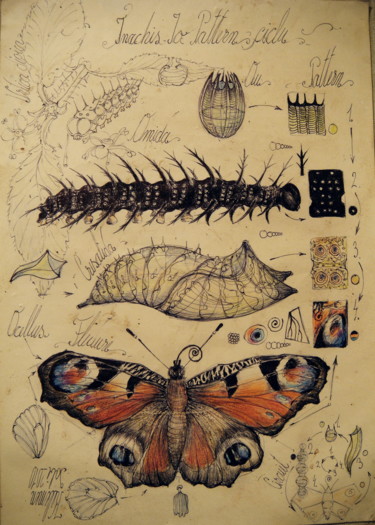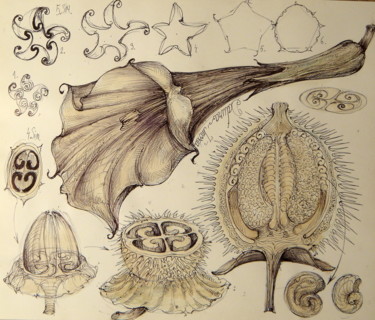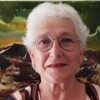Gabriel Kelemen
Gabriel Kelemen, Ph.D., is an artist and researcher, as well as a lecturer and the head of the Art History and Theory department at the West University of Timişoara in Romania. He has spent over 30 years researching how stationary waves form in liquids when stimulated by audible sound frequencies.
Gabriel's experiments are carried out with the rigor and discipline of a physicist, while his artistic sensibility adds playfulness and inventiveness that frequently yields unexpected results. His work has gained widespread acclaim in scientific and artistic circles in his native Romania, and his drawings, photographs, videos, and sculptures are being widely exhibited across Europe.
Gabriel Kelemen was born in Timișoara on June 27, 1968. In 2010, he received his doctorate from the West University of Timişoara's Faculty of Arts and Design. His work has been exhibited internationally and published in numerous magazines.
Discover contemporary artworks by Gabriel Kelemen, browse recent artworks and buy online. Categories: romanian contemporary artists. Artistic domains: Drawing, Photography. Account type: Artist , member since 2007 (Country of origin Romania). Buy Gabriel Kelemen's latest works on Artmajeur: Discover great art by contemporary artist Gabriel Kelemen. Browse artworks, buy original art or high end prints.

Artist Value, Biography, Artist's studio:
1 artwork by Gabriel Kelemen (Selection)
Download as PDFRecognition
The artist is recognized for their work
Artist whose value has great potential for progression
The artist has been published in the media, radio or TV press
The artist studied the arts through his academic studies
Biography
Gabriel Kelemen, Ph.D., is an artist and researcher, as well as a lecturer and the head of the Art History and Theory department at the West University of Timişoara in Romania. He has spent over 30 years researching how stationary waves form in liquids when stimulated by audible sound frequencies.
Gabriel's experiments are carried out with the rigor and discipline of a physicist, while his artistic sensibility adds playfulness and inventiveness that frequently yields unexpected results. His work has gained widespread acclaim in scientific and artistic circles in his native Romania, and his drawings, photographs, videos, and sculptures are being widely exhibited across Europe.
Gabriel Kelemen was born in Timișoara on June 27, 1968. In 2010, he received his doctorate from the West University of Timişoara's Faculty of Arts and Design. His work has been exhibited internationally and published in numerous magazines.
-
Nationality:
ROMANIA

- Date of birth : 1968
- Artistic domains:
- Groups: Romanian Contemporary Artists
Ongoing and Upcoming art events
Influences
Education
Artist value certified
Achievements
Activity on Artmajeur
Latest News
All the latest news from contemporary artist Gabriel Kelemen
Standing waves colection,
Standing wave square powder.
Stationary wave by Gabriel Kelemen
Universal Standing wave Archetype music and video by Gabriel Kelemen
The universality of sphere-spiral principle and the origin of form
Trough Matter, Towards the Sign article, published in Isomorphism magazine, No. 1/March 2012, Art - Interdisciplinary Field
The universality of sphere-spiral principle and the origin of form
Sphere, geometric solid with minimum surface and maximum content, with external curved surface evenly spaced from the centre, is the form having the most homogenous spatial layout. It is prevalent in the universe, the most widespread form both at macro and microcosmic scale, placing the biosphere - humans implicitly - at the confluence of these two worlds.
Spheres hierarchy begins with the stars, huge balls of plasma, continuing with large planets consisting of liquefied gas, then the smaller planets, with many satellites and on Earth with spherical formations of rock, spheres of volcanic origin or limestone cave pearls. Then, in the biosphere, globular forms of fruit - grapes, blueberries - the variety of animal eyes, sphere organs par excellence, looking for light. At microscopic level we come to single-cell organisms, globular-shaped egg cells and at the lower limit to spheroidal atom composed of tiny and impalpable elementary particles.
In imponderable areas, drops of water and other fluids take spherical shape in the absence of gravity due to surface tension acting like an unseen membrane. While rotating a liquid sphere, it tends to become discoid, splashing substance in the equatorial plane due to centrifugal force, like the planet Saturn. At high speed centrifugal effect becomes dominant and the initial sphere becomes a disk similar to the huge galactic gravitational disk, which in turn is contained within the invisible sphere of the halo that circumscribes the galactic disk.
Furthermore, the spiral morphism of cyclic but never identical trajectories, inexorably leads to the capture of a common denominator, linking like an unseen thread that crosses and connects, as integrator principle, microcosm, mesocosm and macrocosm. This code of form is constituted by the indissoluble link of the dualism sphere-spiral, animated by the breath of a harmonic vibration that mediates fusion of three inseparable universal elements.
In many cases we are dealing with screws in space (Earth-Moon tandem describes a double helix on the elliptical orbit around the sun), and the plane of the solar system unparalleled with the galactic disk plane describes a great helix in a galactic year (each planet actually screws around the galactic centre). The spiral is strikingly found in numerous natural formations in the world of minerals (quartz crystals and all crystallizations generating optical antipodes) to complex aggregates which are part of the macromolecular structures of the well-known double dextrogyre helix DNA, the base of functional polymorphism which models by addition and from inside to outside the whole morphology of the living world.
Galaxy is a giant transparent sphere of dark matter that closes at the level of the equatorial disc a double helix made of fluid plasma of the multitude of hot stars that fill the milky arms. The solar system repeats at a lower scale the diffuse structure of the Oort cloud, huge spherical shield made up of particles of water surrounding the disk plane of the solar system.
To summarize, we shift from the spherical galactic halo to spiral disk, and then within each solar system, to spherical gas cloud that includes planetary disk plane. Following the ball-disc relationship for planets we observe concentric spherical structures, attenuated at the outside edges, increasing in density and heat towards the centre - atmosphere, biosphere, lithosphere and at biosphere level, starting with the egg-cell consisting of concentric spheres - cytoplasm, plasma nuclear membrane, the nucleus containing the chromosomal helix composed of DNA filaments.
Turning to the tiny and ultra-fast atomic and subatomic world, the quantum principle of energy-layered orbits closes the string of alternating structures sphere-disk and vortex-torus. Under this system, contented and containing, spiral and vortex, mediate communication and energy transfer from big to small and vice versa.
Can the ball-spiral relationship be reduced to a mere translation from one scale to another as in the dynamic relationship established between two or more concentric spheres mediated by tornado vortex or water whirlwind?
The development of a visual alphabet based on generating regular ensembles of spheres, through successive increases, based on the natural principle of maximum stability, generates both in plane and in three-dimensional increases, cvasiregular formations with the unexpected emergence of the chirality of levogyre and dextrogyre structures (to the left or right). Thus, if the plane six circles of the same diameter surround tangentially a seventh similar one centrally located, one can notice a flat hexagonal network; in three-dimensional space there are 12 identical spheres surrounding a thirteenth one.
Spatial networks made up of spheres of same diameter make the densest symmetrical agglomeration of individuals geometrically identical, at the base of any polyhedron being polyhedral construction composed of spheres. More than modelling by symmetrical polyhedral growth, spheres can form helical structures with polyhedron aspect, encompassing harmonically the regular polyhedron and chiral spirality. So the dynamic unity between symmetrical, spherical and levogyre-dextrogyre spirality, works successfully in shaping alternation from high to low, being found at the level of morphological patterns.
The scale of the spheres from macrodimensional to nanodimensional quantifies, together with spiral, the whole dimensional domain, behaving inextricably like a link which is manifested in the harmonic complementarity sphere-spiral. The concept of chirality both at material level and for living organisms is reflected on the human body with all its features, with visceral asymmetry (heart on the left and liver on the right). Besides the morpho-dynamic abundance of sphere-spiral principle we find a series of irregular formations, nebulae, intergalactic asymmetric clouds, a kind of disorganized materia prima raw material (with a lesser degree of organization, but with a greater degree of freedom) the morphological dynamic from sphere through spiral to explosion (manifestation of the violent radial principle). The resumption of the cycle shows the importance of studying the complex relations from information-vibration-matter to sphere-spiral.
What is true at macroscopic level is also true at microscopic one. Many molecules isolated from plants or animals are chiral. The 20 amino acids resulted from protein hydrolysis, except glycol, are chiral.
In living nature molecules are found either as a single enantiomer, as proteins, carbohydrates and DNA, or in the form of two enantiomers, as menthol, limonene, carvone, etc. Chirality, the molecular asymmetry, is seen in the dominance of spirality and characterizes dynamic nature of living at the molecular level. The biochemical engine, the cyclicality and complexity of inter-networking cell-genetic code, together with the entire causal chain is found at all physiological levels of cell metabolism.
The sensorial interaction of human body with enantiomers' antipodes is different. For example, (-)carvone smells of mint and is found in mint, and (+)carvone smells of caraway and is found in caraway seeds. Morphogen fields are related to the helical engine located in the core of each cell which commands successive metamorphoses in the developing embryo from spherical shape to the final appearance of the specific species. There is a contradiction between the discreet nature of information and continuous nature of morphogenesis, so the DNA does not contain sufficient information to carry out morphogenesis. Genotype-phenotype interaction is crucial in shaping natural forms in the cosmo-geo-climatic context. Through the interaction of rhythmic fluctuations with genetic factor, the great work of ontogenesis is carried out.
This is sustained by the French mathematician René Thom (1923-2002). He affirms that matter and form each have separate laws. Morphogenesis is independent of chemical substrate's properties. According to the theory of René Thom catastrophe occurs when "a continuous variation of causes produces a discontinuous variation of effects." Another fundamental methodological feature of the morphological theories, along with the principle of independence of form in relation to matter, is their holism. Forms are regarded as "not only autonomous but also global, ie the wholes are not reducible to the sum of their components." The forms' behaviour and growth become paradoxical. By the primacy of growing algorithm for interior reasons on the one side, or by inserting into a pre-generated matrix prior to the developing shape, out of the primary group of cells (stem cells develop in context), form is not deducted only from the aggregation of its separate parts.
The modelling of life from the incipient fertilized sphere and following the succession of metamorphoses of the embryo, goes through incredible stages from one form to another, which, following divisions controlled from within, overlapping with the contribution to external influences, lead gradually to cells structure. At first vaguely differentiated, with the growth and diversification of incipient organs one can notice a gradual morphological transformation of the fertilized zygote sphere, metaphorical structure of the principle of multiple dynamic multiple masculine spiral-spermatozoon merged through fecundatio with static single female sphere-ovule.
Following the gradual transformation of zygote sphere, it is first divided into two spheres (first division - the appearance of 2: line), then 4 (square / tetrahedron) via 8-cell stage (cube), then 16 - a morula stage with a polyhedron symmetrical geometric aspect dominated by sphere. After a while, this ball of cells with a free centre folds inwards becoming blastula, this transformation being done under the auspices of the dominant first-degree spherical vortex. Once this progressive alternation started, the organizing tandem sphere-spiral varies continuously, modelling cellular increases and decreases into more and more differentiated organs. After implantation, ie landing and penetration into the uterine wall, Athanor of life, the embryo gradually loses spherical symmetry of the blastula, developing outward. Placenta occurs in the globular shell subsequent to the initial spherical shape, having a wrinkled appearance, becoming root-barrier that protects and nourishes the colony of cells within this globular space of reaction.
The transformation stages continues dividing the spheroid inside the placenta into two attached globules - amnios and yolk sac - like two bubbles, while the membrane consisting of three layers that separate equatorial-like the two chambers filled with liquid folds under the direct manifestation of the modelling forces exerted by the vortex of the three embryonic layers. Those, discoidal initially, curve towards the amniotic fluid, being attached and reabsorbed, animated by a vortex similar to mushroom development. The same type of development is found in many embryonic lines from both kingdoms of life - shellfish class, jellyfish, octopus, almost all types of mushrooms remaining in the convective vortex stage.
Dr. Gabriel Kelemen
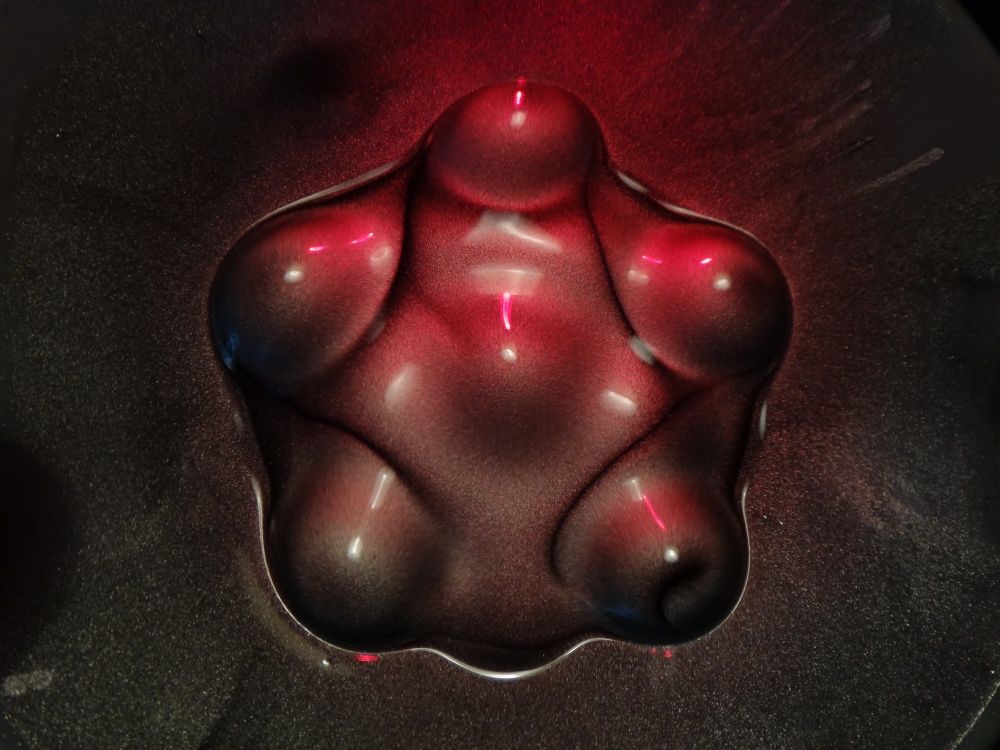
liquid standing wave
standing wave colection
Reviews and comments
